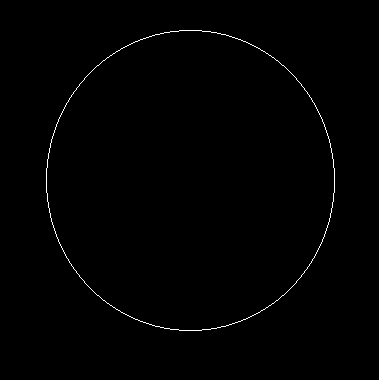Phases of the Moon (in the Northern Hemisphere)


The Moon goes through all of its phases once in about 29.4 days as observed from the Earth. See here for more details.
From
any location on the Earth, the Moon appears to be a circular disk which,
at any specific time, is illuminated to some degree by direct sunlight.
Like the Earth, the Moon is a sphere which is
always half illuminated by the Sun, but as the Moon orbits the Earth
we get to see more or less of the illuminated half.
Note that the order we see them in is 'clockwise' - if you can see the right hand side you are in the first half of the lunar cycle.
Also note that a 'half moon' is actually called either a first or last (third) quarter!
During each lunar orbit of our Earth (a lunar
month), we see the Moon's appearance change from not visible, through
partially illuminated to fully illuminated, then back through partially
illuminated to not illuminated again. Although this cycle is a continuous
process, there are eight distinct, traditionally recognised stages,
called phases.
The phases designate both the degree to which
the Moon is illuminated and the geometric appearance of the illuminated
part. These phases of the Moon, in the sequence of their occurrence
(starting from New Moon), are listed below.
|

|
 |
 |
 |
 |
| New
Moon - The Moon's un-illuminated side is facing
the Earth. The Moon is not visible (except during a solar eclipse). |
Waxing
Crescent - The Moon appears to be partly but
less than one-half illuminated by direct sunlight. The fraction of the Moon's
disk that is illuminated is increasing.The first time that the thin waxing
crescent Moon is visible after New Moon (low in the evening sky just after
sunset) marks the beginning of a month in the Islamic Calendar |
First
Quarter - One-half of the Moon appears to be
illuminated by direct sunlight. The fraction of the Moon's disk that is
illuminated is increasing. |
Waxing
Gibbous - The Moon appears to be more than
one-half but not fully illuminated by direct sunlight. The fraction of the
Moon's disk that is illuminated is increasing. |
 |
 |
 |
 |
Full
Moon - The Moon's illuminated side is facing
the Earth. The Moon appears to be completely illuminated by direct sunlight.
Although Full Moon occurs each month at a specific date and time, the Moon's
disk may appear to be full for several nights in a row if it is clear. This
is because the percentage of the Moon's disk that appears illuminated changes
very slowly around the time of Full Moon (also around New Moon, but the
Moon is not visible at all then). The Moon may appear 100% illuminated only
on the night closest to the time of exact Full Moon, but on the night before
and night after will appear 97-99% illuminated; most people would not notice
the difference. Even two days from Full Moon the Moon's disk is 93-97% illuminated.
The cycle of the phases is shorter than most calendar
months, therefore the phase of the Moon at the very beginning of the calendar
month usually repeats at the very end of the month. When there are two Full
Moons in a month (which occurs, on average, every 2.7 years), the second
one is called a "Blue Moon" |
Waning
Gibbous - The Moon appears to be more than
one-half but not fully illuminated by direct sunlight. The fraction of the
Moon's disk that is illuminated is decreasing. |
Last
(or third) Quarter - One-half of the Moon appears to be
illuminated by direct sunlight. The fraction of the Moon's disk that is
illuminated is decreasing. |
Waning
Crescent - The Moon appears to be partly but
less than one-half illuminated by direct sunlight. The fraction of the Moon's
disk that is illuminated is decreasing. |
The
percentage of the Moon's surface illuminated is a more refined, quantitative
description of the Moon's appearance than is the phase.
Considering the Moon as a circular disk, the ratio of the area illuminated by
direct sunlight to its total area is the fraction of the Moon's surface illuminated;
multiplied by 100, it is the percentage illuminated. At New Moon the percentage
illuminated is 0; at First and Last Quarters it is 50%; and at Full Moon it
is 100%. During the crescent phases the percentage illuminated is between 0
and 50% and during gibbous phases it is between 50% and 100%.
For
practical purposes, phases of the Moon and the percentage of the Moon illuminated
are independent of the location on the Earth from where the Moon is observed.
That is, all the phases occur at the same time
regardless of the observer's position.
















